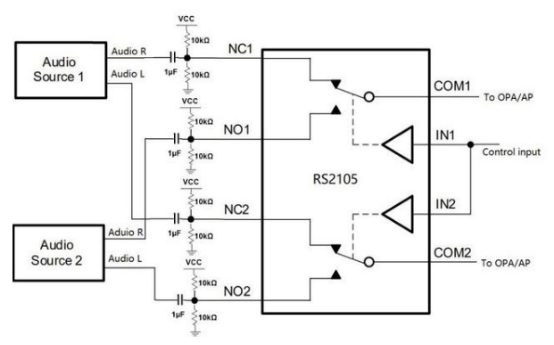What is the design method of analog switch to switch audio signal?
On noise-reducing headphones, speakers, KVM, matrix, mixers and other products, it is often necessary to process multiple audio signals. Designing a set of conditioning units for each audio signal will be very expensive and the circuit will be very complicated. It is obviously a very convenient design idea to use analog switches for time-sharing switching and multiplexing. Audio signals (including other AC signals) are time-multiplexed with analog switches. Currently, the following design schemes are mainly used:
1) The analog switch powered by an ordinary single power supply, the signal range that the ordinary analog switch can pass is -0.3V ~ VCC, for switching audio signals and other AC signals, the DC bias voltage should be superimposed, that is, the signal must be raised to zero volts The above can be passed reliably (refer to Figure 1), each channel needs to add 3 resistance-capacitance components; of course, if the signal itself has a DC bias voltage, it can be directly given to the analog switch.
2) Analog switch with dual power supply, analog switch with dual power supply, including analog switch with built-in negative pressure charge pump, the dynamic range of the signal that can be passed is larger, such as 74HC4051, -VEE ~ + VCC signal is supported Range, but the production of negative power needs to add some components or chips, the cost will increase significantly.

3) Using analog switches with negative swing capability, there is a class of switches with negative swing specifically designed for AC signals, such as RS2117 and RS2118. The maximum negative voltage signal that can be passed under a single power supply can reach -2V. Use this Switch-like audio signal switching circuit is the most simple and cost-effective (see Figure 2).
4) Use relays. Relays are the best choice for performance, with small on-resistance and good isolation, but they are bulky and costly.
RS2117 / RS2118 is Runshi Technology's dual-channel single-pole double-throw (SPDT) analog switch, its main features are as follows: -3dB bandwidth: 400MHz / RS2117, 80MHz / RS2118 low on-resistance: 4.0Ω / RS2117, 0.8Ω / RS2118 operation Voltage range: 2.5V ~ 5.5V; maximum pass signal range: -2V ~ VCC; ultra-low power consumption: <= 1uA; high shutdown isolation: -70dB @ 1MHz; high channel isolation: -72dB @ 1MHz to provide QFN -1.4x1.8-10L small package Note: The smaller the on-resistance is, the larger the current that can pass. RS2118 is more suitable for switching with load.
Special attention should be paid to the design. The negative voltage signal range that RS2117 / RS2118 can pass is subject to the VCC supply voltage, that is, the negative voltage that can pass is VCC-5.5V, the minimum is -2V, such as 3.3V power supply, the signal range that can pass It is -2V ~ 3.3V, or the supply voltage is in the range of 2.5V ~ 3.5V to get the maximum negative swing range.
If you want to know more, our website has product specifications for analog switch, you can go to ALLICDATA ELECTRONICS LIMITED to get more information

